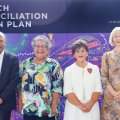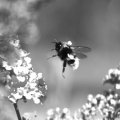University of Queensland Vice-Chancellor Professor John Hay will open newly-refurbished biological laboratories for one of the University's flagship research centres on June 23.
The Centre for Microscopy and Microanalysis (CMM) has undertaken a $200,000 refurbishment of its biological sciences laboratory and office area in the University's Otto Hirschfeld Building.
The CMM is a high-demand centre with instrumentation used by researchers at the three big Brisbane universities, and by industry, to study the minute or tiny, whether it be atoms, pollen, the structure of steel or even the hairs on a bee's knee.
The Centre has its origins in the Electron Microscope Unit formed in 1962 within the Anatomical Sciences Department. From a $250,000 per annum operation nine years ago, the Centre now has a multi-million budget and some $8 million worth of the latest equipment to analyse the structure and composition of materials in great detail.
In 1988 Dr Mackinnon, as foundation director of the CMM predicted that the University would have one of the best, most respected centres for electron microscopy in Australia, if not the world.
With a new brief and funding, it has since undergone major development and now serves the University's needs as well as being a centre for leading-edge research and industry problem-solving.
Innovative and commercially marketable research at the CMM includes work on high temperature superconducting materials; a new material, KAD, which soaks up toxic metal pollutants from acid mine wastewater; and the detection of defects in glass windows and balconies in high-rise buildings.
Professor Mackinnon said the Otto Hirschfeld laboratories were built in the 1960s, and renovated and converted into a microscopy suite in the 1980s. The laboratories were no longer compatible with 1990s instrumentation and techniques, and not conducive to the research needs of modern biological electron microscopy.
'With the arrival of three senior research staff last year and new instrumentation it was critical that the biological unit of the CMM be upgraded,' he said.
'All our goals for restaffing, rehousing and getting better instruments have been achieved, but microscopy, like all science and technology, does not remain static.
'Progress demands that 10 years on, a second phase of restaffing, rehousing and acquiring better instruments is paramount for the future, and this refurbishment is part of a strategy to position the Centre for the 21st century.
'As part of these advances we have also recently installed cutting-edge instrumentation for cryo-microtomy and immunolabelling - crucial tools for leading-edge biological electron microscopy.'
Professor Mackinnon said the CMM had specialist research centres in a number of buildings on the University's St Lucia campus and would also participate in a new $50 million Institute for Molecular Bioscience to keep the State globally competitive in biotechnology.
For further information, contact Professor Mackinnon, telephone 07 3365 4211/3365 4117 or Associate Professor Alasdair McDowall, telephone 07 3365 6456.



